New Sensing Technologies for Grain Moisture
Abstract
1. Introduction
2. Methods
2.1. Direct Methods for Grain Moisture Measurement
2.1.1. Gravimetric/Oven Method
2.1.2. Distillation Method
2.1.3. Coulometry Method (Karl Fischer KF)
2.2. Indirect Methods for the Determination of Moisture Content in Grain
2.2.1. Electrical Resistance/Impedance Method
2.2.2. Dielectric Constant Change
2.2.3. Microwave Method
2.2.4. Magnetic Measurement Method
2.2.5. Magnetic Resonance Method
2.2.6. Ultra-Wideband (UWB) Radar Method
2.2.7. Ultrasonic Method (Acoustic Method)
2.2.8. Infrared Thermography (IR) Method
2.2.9. Infrared Spectroscopy
2.2.10. Hyperspectral Imaging (HSI)
2.2.11. Equilibrium Relative Humidity (ERH)
3. New Techniques for Determining Moisture in Grains
3.1. Visible Spectrum Analysis
3.2. RF-Based Moisture Content and Artificial Neural Network
3.3. Prediction Using ANN and SVR Modeling Techniques
3.4. Grain Moisture Determination by Complex Permittivity and Compression
3.5. Microwave Attenuation at 10.5 GHz and Humidity Density
3.6. Temperature and Humidity Control
3.7. Online Measurement by Resistance Sensor
3.8. Indirect Determination of Moisture Using the Biospeckle Technique
3.9. Moisture Content in the Mechanical Properties of Grains
3.10. Moisture Content Measurement with Inspection Card
3.11. Evaluation of Grain Moisture Content by the Dielcometric Method
4. Discussion
5. Results
6. Conclusions
Author Contributions
Funding
Conflicts of Interest
References
- Blanco, Y.; Durañona, H.; Acosta, R. Efecto de la temperatura y la humedad en la conservación de granos de maíz en silos metálicos refrigerados. Cultiv. Trop. 2016, 37, 105–114. [Google Scholar] [CrossRef]
- Zapata, S.A.; Velásquez, D.P.; Torres, I.D. Desarrollo e Implementación de un Sistema de Visión Artificial basado en Lenguajes de Uso Libre para un Sistema Seleccionador de Productos de un Centro Integrado de Manufactura CIM. Lámpsakos 2016, 30, 43–50. [Google Scholar] [CrossRef]
- Yigit, E.; Sabanci, K.; Toktas, A.; Ustun, D.; Duysak, H. Grain Moisture Detection by Using A-Scan Radar Measurement. In Proceedings of the XXIIIrd International Seminar/Workshop on Direct and Inverse Problems of Electromagnetic and Acoustic Wave Theory (DIPED), Tbilisi, Georgia, 24–27 September 2018; pp. 222–224. [Google Scholar] [CrossRef]
- Yang, L.; Zheng, Y.; Jiang, Z.; Ren, Z. Improvement of the Capacitive Grain Moisture Sensor. In IFIP Advances in Information and Communication Technology; Springer: Berlin/Heidelberg, Germany, 2012; pp. 300–307. [Google Scholar] [CrossRef]
- Raudienė, E.; Rušinskas, D.; Balčiūnas, G.; Juodeikienė, G.; Gailius, D. Carbon Dioxide Respiration Rates in Wheat at Various Temperatures and Moisture Contents. Mapan 2017, 32, 51–58. [Google Scholar] [CrossRef]
- Juodeikiene, G.; Basinskiene, L.; Vidmantiene, D.; Bartkiene, E.; Bakutis, B.; Baliukoniene, V. Acoustic sensing of deoxynivalenol in co-occurrence with zearalenone and T-2/HT-2 toxin in winter wheat cultivar Sirvinta from Lithuania. World Mycotoxin J. 2011, 4, 395–404. [Google Scholar] [CrossRef]
- Kaletam, A.; Górnicki, K. Criteria of determination of safe grain storage time—A review. In Advances in Agrophysical Research; 2013; pp. 295–318. Available online: https://www.researchgate.net/publication/284470369_Criteria_of_determination_of_safe_grain_storage_time_-_A_review (accessed on 12 December 2021).
- Zhang, S.-B.; Zhai, H.-C.; Huang, S.-X.; Cai, J.-P. A site-directed CO2 detection method for monitoring the spoilage of stored grains by insects and fungi in Chinese horizontal warehouses. J. Stored Prod. Res. 2014, 59, 146–151. [Google Scholar] [CrossRef]
- Oliveros, C.E.; López, L.; Buitrago, C.M.; Moreno, E.L. Determinación del contenido de humedad del café durante el secado en silos. Cenicafé 2010, 61, 108–118. Available online: https://biblioteca.cenicafe.org/bitstream/10778/488/1/arc061%2802%29108-118.pdf (accessed on 12 November 2021).
- Bartosik, R.; Cardoso, L.; Piñeiro, E. Comparación de Determinación de Humedad de Semillas de Especies Forrajeras por Método de Estufa y a Través de Instrumento de Medición Electrónico por Capacitancia; INTA: New York, NY, USA; pp. 1–4. Available online: https://inta.gob.ar/sites/default/files/script-tmp-gacetillacomparacdetermhumedad.pdf (accessed on 12 November 2021).
- Stuart, O.N.; Samir, T. Use of Grain and Seed Dielectric Properties for Moisture Measurement. In Agricultural Research Service; 2011; pp. 201–206. Available online: https://www.researchgate.net/publication/329813996_Use_of_Grain_and_Seed_Dielectric_Properties_for_Moisture_Measurement (accessed on 15 December 2021).
- Norma Técnica Ecuatoriana. Maiz. Determinacion del Contenido de Humedad (En Granos Molidos y Granos Enteros) (IDT) (Norma Núm. 6540). 2013. Available online: https://drive.google.com/file/d/1GL-pYyWRxBaP91rL5pVZzQbbUdyoSaDp/view (accessed on 15 December 2021).
- Marchant, M. Medición de Humedad en Granos Metodo Gravimetrico; Empresa Nacional Aereonautica de Chile: Santiago, Chile, 2016; pp. 1–3. Available online: https://www.metrologia.cl/medios/humedad_grano.pdf (accessed on 16 December 2021).
- Arias, C. Manual de Manejo Poscosecha de Granos a Nivel Rural; Oficina Regional de la FAO para America Latina y el Caribe: Santiago, Chile, 1993; Available online: http://www.fao.org/3/x5027s/x5027S00.htm (accessed on 18 December 2021).
- Ahmaed, U.; Kumar, M.; Salamdin; Mahajan, B.V.C.; Alam, M.S. Grain Moisture Measuring Techniques-A review. Agric. Eng. Today 2015, 39, 13–16. [Google Scholar]
- Scholz, E.; Karl Fischer Titration. Determination of Water. In Chemical Laboratory Practice with Selected Applications; Springer: Berlin/Heidelberg, Germany; New York, NY, USA, 1984. [Google Scholar]
- Tavcar, E.; Turk, E.; Kreft, S. Simple Modification of Karl-Fischer Titration Method for Determination of Water Content in Colored Samples. J. Anal. Methods Chem. 2012, 2012, 379724. Available online: https://www.ncbi.nlm.nih.gov/pmc/articles/PMC3335423/ (accessed on 12 November 2021). [CrossRef]
- Sadaka, S.; Rosentrater, K.A. Tips on Examining the Accuracy of On-Farm Grain Moisture Meters. In Agriculture and Natural Resources; UAEX: Fayetteville, AR, USA, 2019; pp. 1–5. Available online: https://www.uaex.edu/publications/PDF/FSA1094.pdf (accessed on 12 November 2021).
- Tsukada, K.; Kiwa, T. Magnetic Measurement of Moisture Content of Grain. IEEE Trans. Magn. 2007, 6, 2683–2685. [Google Scholar] [CrossRef]
- Wendt, T.; Neufeld, R.; Kossakowska, A.; Zhang, C. Hydranal Manual for Karl Fischer Titration. Research Chemicals Portafolio. 2020, pp. 1–78. Available online: https://lab.honeywell.com/content/dam/rc/en/resources/resource-library/hydranal-manuals/pmt-rc-661-hydranal-manual.pdf (accessed on 18 December 2021).
- Briggs, L.J. An Electrical Resistance Method for the Rapid Determination of the Moisture Content of Grain. Science 1908, 28, 810–813. [Google Scholar] [CrossRef]
- Kandala, C.V.; Sundaram, J. Estimating the moisture content of grain from impedance and phase angle measurements. In Proceedings of the IEEE Sensors Applications Symposium, New Orleans, LA, USA, 17–19 February 2009; pp. 65–69. Available online: https://ieeexplore.ieee.org/abstract/document/4801779 (accessed on 26 March 2021).
- Guerrero, P.M. Análisis comparativo de la Medición del Contenido de Humedad con Los Medidores de las Marcas DICKEY-John, Gehaka, Motomco y Grainman en Frijol Nacional Rojo Variedad Cabécar y Negro Variedad Guaymí. Posgrado, Universidad de Costa Rica, Ciudad Universitaria Rodrigo Facio. 2011. Available online: https://www.ingbiosistemas.ucr.ac.cr/wp-content/uploads/2015/08/4Analisiscomparativohumedad.pdf (accessed on 18 December 2021).
- Sitong, W.; Boyuan, Z.; Yinghui, T.; Shaolei, Z.; Haitao, M. A grain moisture model based on capacitive sensor. J. Phys. Conf. Ser. 2018, 1074, 012120. [Google Scholar]
- Nelson, S.T.; Trabelsi, S.; Kraszewski, A.W. Principles of microwave moisture measurement in grain. In Proceedings of the IEEE Instrumentation and Measurement Technology Conference 2002, Anchorage, AK, USA, 21–23 May 2002; Volume 1, pp. 99–102. Available online: https://ieeexplore.ieee.org/document/1006822 (accessed on 16 March 2021).
- Nelson, S.O.; Samir, T. Principles for microwave moisture and density measurement in grain and seed. J. Microw. Power Electromagn. Energy 2004, 39, 107–117. [Google Scholar] [CrossRef] [PubMed]
- Tsukada, K.; Kiwa, T.; Masuda, Y. AC magnetic properties of large volume of wáter-Susceptivility measurement in unshielded environment. Jpn. J. Appl. Phys. 2006, 45, L1097–L1099. [Google Scholar] [CrossRef]
- Aristizábal, I.D. La Resonancia Magnética y sus Aplicaciones en la Industria. Rev. Fac. Nac. Agron. Medellín 2007, 60, 4037–4066. Available online: http://www.scielo.org.co/pdf/rfnam/v60n2/a12v60n2.pdf (accessed on 17 March 2021).
- Brusewitz, G.H.; Stone, M.L. Wheat moisture by NMR. Trans. ASAE 1987, 30, 858–862. [Google Scholar] [CrossRef]
- Wolter, B.; Krus, M. Moisture Measuring with Nuclear Magnetic Resonance (NMR). In Electromagnetic Aquametry n.d; Springer: Berlin/Heidelberg, Germany, 2005; pp. 491–515. [Google Scholar] [CrossRef]
- Ruan, R.R.; Chen, P.L. Water in Foods and Biological Materials, 1st ed.; CRC Press: Washington, DC, USA, 1997; 312p, Available online: https://www.routledge.com/Water-in-Foods-and-Biological-Materials/Ruan-Chen/p/book/9781566765893 (accessed on 18 March 2021).
- Zhang, C.; Shi, Z.; Yang, H.; Zhou, X.; Wu, Z.; Jayas, D.S. A Novel, Portable and Fast Moisture Content Measuring Method for Grains Based on an Ultra-Wideband (UWB) Radar Module and the Mode Matching Method. Sensors 2019, 19, 4224. [Google Scholar] [CrossRef]
- Healy, W.M.; Doorn, E.V. Detection of Moisture Accumulation in Wall Assemblies Using Ultra-Wideband Radio Signals. ASHRAE. 2004. Available online: https://web.ornl.gov/sci/buildings/conf-archive/2004%20B9%20papers/122_Healy.pdf (accessed on 18 March 2021).
- Rathod, V.T. A Review of Acoustic Impedance Matching Techniques for Piezoelectric Sensors and Transducers. Sensors 2020, 20, 4051. [Google Scholar] [CrossRef]
- López, E. Importancia de la Metrología en la Determinación del Contenido de Humedad en Granos; Laboratorio de Humedad en Sólidos, División Termometría, Metrología Eléctrica, Centro Nacional de Metrología: El Marqués, Mexico, 2012; pp. 1–41. Available online: http://www.cenam.mx/eventos/enme/docs/5 Importancia metrología humedad en granos final.pdf (accessed on 19 December 2021).
- García, S.; Galvez, L.; Martínez, J.; Muelas-Domingo RNieves, M. Using Near-Infrared Spectroscopy in Agricultural Systems. Mendeley. 2017. Available online: https://www.mendeley.com/catalogue/d02c119a-494f-366f-9fea-59c271796343/ (accessed on 19 December 2021).
- Yu, H.; Guo, L.; Kharbach, M.; Han, W. Multi-Way Analysis Coupled with Near-Infrared Spectroscopy in Food Industry: Models and Applications. Foods 2021, 10, 802. [Google Scholar] [CrossRef]
- Haque, A.; Shimizu, N.; Kimura, T. Equilibrium relative humidity or water activity of brown rice (Japonica variety). J.-Stage 2004, 566, 4–11. [Google Scholar]
- Kumar, B.; Mishra, G.; Ariza, W.; Hyewon JSingh, C.; Lee, S.; Lee, I. Rancidity and moisture estimation in shelled almond kernels using NIR hyperspectral imaging and chemometric analysis. J. Food Eng. 2022, 318, 1108889. [Google Scholar] [CrossRef]
- Chen, A.; Chen, H.Y.; Chen, C. Use of Temperature and Humidity Sensors to Determine Moisture Content of Oolong Tea. Sensors 2014, 14, 15593–15609. [Google Scholar] [CrossRef] [PubMed]
- Reddy, N.G.; Anand, K.; Priyadharshini, R.; Rajeshwari, K. Estimation of durability of rice grains using sensors and mobile technology. In Proceedings of the IEEE Technological Innovations in ICT for Agriculture and Rural Development (TIAR), Chennai, India, 15–16 July 2016; pp. 33–35. [Google Scholar] [CrossRef]
- Hap, C.; Villamarín, D.; Velásquez, J.; Vásquez, W. Comparison of methodologies for determination total humidity in hard corn (Zea mays L.). IOP Conf. Ser. Earth Environ. Sci. 2009, 250, 012070. [Google Scholar] [CrossRef]
- Agrichem. Grain Moisture Measurement with Capacitance Type Devices. 1965. Available online: https://www.agricheminc.com/downloads/Feedgrain-297.pdf (accessed on 20 December 2021).
- Trabelsi, S.; Nelson, S.O.; Lewis, M. Microwave Moisture Sensor for Grain and Seed. Biol. Eng. 2008, 1, 195–202. [Google Scholar] [CrossRef]
- Muzalevskiy, M. Ultra-wideband impulse sensing of the layered structure of the snow-soil cover. J. Radio Electron. 2020, 8, 4. [Google Scholar] [CrossRef]
- Misra, M.K.; Koemer, B.; Pate, A.; Burger, C.P. Acoustic properties of soybeans. Am. Soc. Agric. Biol. Eng. 1990, 33, 671–680. [Google Scholar] [CrossRef][Green Version]
- Rudik, F.; Morgunova, N.; Semilet, N.; Tuyiyeva, M. Improvement of grain processing via ultrasonic treatment. In Proceedings of the Innovations in Agricultural and Rural Development, Kurgan, Russia, 18–19 April 2019; Volume 12, p. 1491. [Google Scholar]
- Mettler-Toledo. Determinación de la Humedad Mediante el Analizador Halógeno de Humedad. Guía Práctica. 2015, pp. 1–44. Available online: https://www.mt.com/dam/P5/labtec/05_Moisture_Analyzer/00_Family/05_Documents/01_Broschures/Guide_To_Moisture_Analysis_ES.pdf (accessed on 21 December 2021).
- Messina, G.; Modica, G. Applications of UAV Thermal Imagery in Precision Agriculture: State of the Art and Future Research Outtlook. J. Remote Sens. 2020, 12, 1491. [Google Scholar] [CrossRef]
- Koprivica, B.; Snezana, D.; Sucurovic, M. Infrared Thermography with Integrated Thermal Sensor Array, International Scientific Conference on Defensive Technologies. 2020. Available online: http://www.vti.mod.gov.rs/oteh/elementi/rad/060.pdf (accessed on 21 December 2021).
- Barreira, E.; Almeida, R.M.; Delgado, J.M. Infrared thermography for assessing moisture related phenomena in building components. Constr. Build. Mater. 2016, 110, 251–260. [Google Scholar] [CrossRef]
- Dutta, B.; Raghavan, V.G.; Orsat, V.; Ngadi, M. Surface characterisation and classification of microwave pyrolysed maple wood biochar. Biosyst. Eng. 2015, 131, 49–64. [Google Scholar] [CrossRef]
- Huang, M.; Wang, Q.; Zhang, M.; Zhu, Q. Prediction of color and moisture content for vegetable soybean during drying using hyperspectral imaging technology. J. Food Eng. 2014, 128, 24–30. [Google Scholar] [CrossRef]
- Pixton, S.; Warburton, S. Moisture content/relative humidity equilibrium of some cereal grains at different temperatures. J. Stored Prod. Res. 1971, 6, 283–293. [Google Scholar] [CrossRef]
- Azmi, N.; Kamarudin, L.M.; Zakaria, A.; Ndzi, D.L.; Rahiman, M.H.F.; Zakaria, S.M.M.S.; Mohamed, L. RF-Based MoistureContent Determination in Rice Using Machine Learning Techniques. Sensors 2021, 21, 1875. [Google Scholar] [CrossRef] [PubMed]
- Abdollahpour, S.; Moghaddam, A.K.; Bannayan, M. Prediction of wheat moisture content at harvest time through ANN and SVR modeling techniques. ScienceDirect 2020, 7, 500–510. [Google Scholar] [CrossRef]
- Wang, R.; Han, F.; Jin, Y.; Wu, W. Correlation between moisture content and machine vision image characteristics of corn kernels. Int. J. Food Prop. 2020, 23, 319–328. [Google Scholar] [CrossRef]
- Tahir, A.R.; Neethirajan, S.; Jayas, D.S.; Shahin, M.A.; Symons, S.J. White, NDG Evaluación del efecto del contenido de humedad en granos de cereales mediante análisis de imágenes digitales. Food Res. Ent. 2007, 40, 1140–1145. [Google Scholar] [CrossRef]
- Liu, X.; Chen, X.; Wu, W.; Peng, G. A neutral network for predicting moisture content of grain drying process using genetic algorithm. Food Control 2007, 18, 928–933. [Google Scholar] [CrossRef]
- Lachhwani, K. Application of Neural Network Models for Mathematical Programming Problems: A State of Art Review. Arch. Computat. Methods Eng. 2020, 27, 171–182. [Google Scholar] [CrossRef]
- Cai, Y.L.; Ji, D.; Cai, D.F. A KNN Ressearch Paper Classification Method Based on Shared Nearest Neighbor. Natural Language Processing Research Laboratory; Shenyang Institute of Aereonautical Engineering: Shenyang, China, 2010; Available online: https://research.nii.ac.jp/ntcir/workshop/OnlineProceedings8/NTCIR/07-NTCIR8-PATMN-CaiY.pdf (accessed on 12 November 2021).
- Chua, H.S.; Parkinson, G.; Haigh, A.D.; Gibson, A.P. A method of determining the moisture content of bulk wheat grain. J. Food Eng. 2007, 78, 1155–1158. [Google Scholar] [CrossRef]
- Kim, K.B.; Kim, J.H.; Lee, S.S.; Noh, S.H. Measurement of grain moisture content using microwave attenuation at 10.5 GHz and moisture density. IEEE Trans. Instrum. Meas. 2002, 51, 72–77. [Google Scholar] [CrossRef]
- Wu, W.; Wu, Z.; Liu, Z.; Chen, S.; Zhang, Y.; Han, F.; Xu, Y.; Zhang, Z.; Li, X.; Wu, Y.; et al. A kind of Silo Internal Point Grain Measurement of Moisture Content Method Based on Warm and Humid Monitoring. Patent No. CN104237056B, 14 September 2016. Available online: https://patents.google.com/patent/CN104237056B/en?oq=CN104237056 (accessed on 12 November 2021).
- Chen, C. Moisture Measurement of grain using humidity sensors. Am. Soc. Agric. Biol. Eng. 2001, 44, 1241–1245. [Google Scholar] [CrossRef]
- Li, C.; Li, B.; Huang, J.; Li, C. Developing an Online Measurement Device Based on Resistance Sensor for Measurement of Single Grain Moisture Content in Drying Process. Sensors 2020, 20, 4102. [Google Scholar] [CrossRef]
- Pandiselvam, R.; Mayookha, V.P.; Kothakota, A.; Ramesh, S.V.; Thirumdas, R.; Juvvi, P. Biospeckle laser technique-A novel non-destructive approach for food quality and safety detection. Trens Food Sci. Technol. 2020, 97, 1–13. Available online: https://www.sciencedirect.com/science/article/abs/pii/S0924224419304625 (accessed on 12 November 2021). [CrossRef]
- Outo, S.M. Comportamento Mecânico de Frutos de café: Módulo de Deformidade. Revista Brasileira de Engenharia Agrícola e Ambiental. 2002. Available online: http://www.scielo.br/pdf/rbeaa/v6n2/v6n2a18.pdf (accessed on 5 August 2016).
- Resende, O.; Corrêa, P.C.; de Oliveira, G.H.; Goneli, A.L.; Jarén, C. Mechanical properties of rough and dehulled rice during drying. Int. J. Food Stud. 2013, 2, 158–166. [Google Scholar] [CrossRef]
- Fernandes, L.S.; Corrêa, P.C.; Diniz, M.D.; Leite, D.M.; Vasconcellos, D.D. Influência do teor de água nas propriedades mecânicas dos grãos de trigo submetidos à com-pressão. Biosci. J. 2014, 30, 219–223. [Google Scholar]
- Rsende, O.; Ferreira, R.B.; Ullmann, R.; Oliveira, D.M.; Correa, P.C.; Costa, L.M. Moisture content on the mechanical behavior of crambe grains. J. Scielo Bras. Cienc. Rural 2018, 48, e20160748. [Google Scholar] [CrossRef]
- Pathaveerat, S.; Pruengam, P. Low cost measurement of moisture content in long grain paddy. J. Stored Prod. Res. 2020, 89, 101728. [Google Scholar] [CrossRef]
- Eroshenko, G.P.; Sharuev, N.K.; Evstaf’ev, D.P. A Technique of Evaluating an Idealized Mathematical Model for Monitoring the Moisture Content of Grain by a Dielcometric Method. Meas. Tech. 2017, 59, 1324–1329. Available online: https://link.springer.com/article/10.1007/s11018-017-1136-0 (accessed on 22 December 2021). [CrossRef]
- Eroshenko, G.P.; Sharuev, N.K.; Parusov, V.P.; Sharuev, V.N. Expanding the functional capabilities of the dielcometric method in monitoring the parameters of milk products. Izmer. Tekhn. 1999, 9, 61–63. [Google Scholar]
- Biau, G. Analysis of a Random Forest Model. J. Mach. Learn. Res. 2012, 13, 1063–1095. [Google Scholar]
- Kaur, J.; Singh, M.; Baind, P.S.; Singh, G. Analysis of Multi Layer Perceptron Network; Department of Electronics and Communication Engineering, Chandigarh University: Punjab, India, 2013; Volume 13, pp. 600–604. Available online: https://1library.net/document/q5936egz-analysis-of-multi-layer-perceptron-network.html (accessed on 22 December 2021).
- Javier, M.; Muñoz, M.A. Support Vector Machines with Applications. Statist 2006, 21, 322–336. [Google Scholar] [CrossRef]
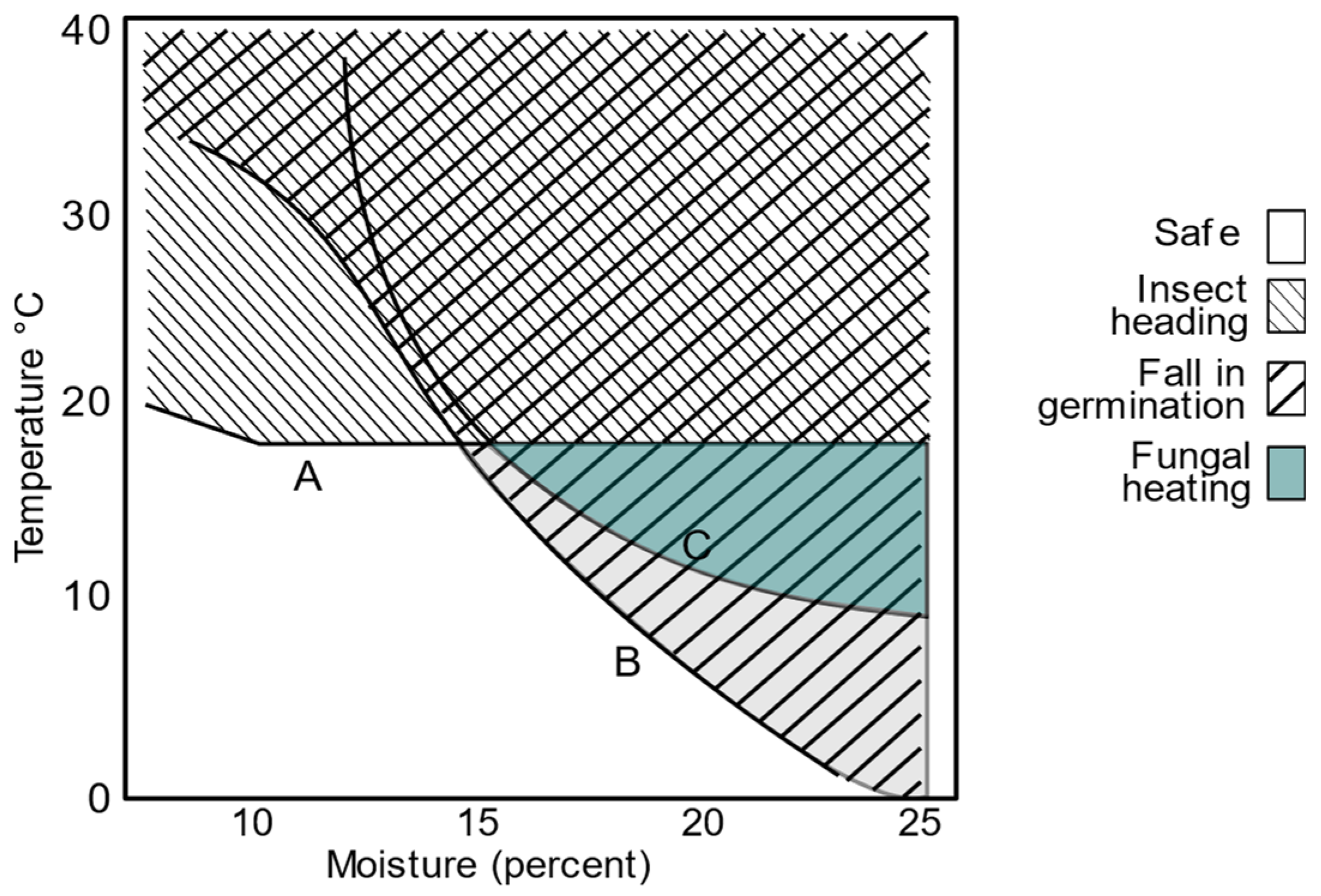
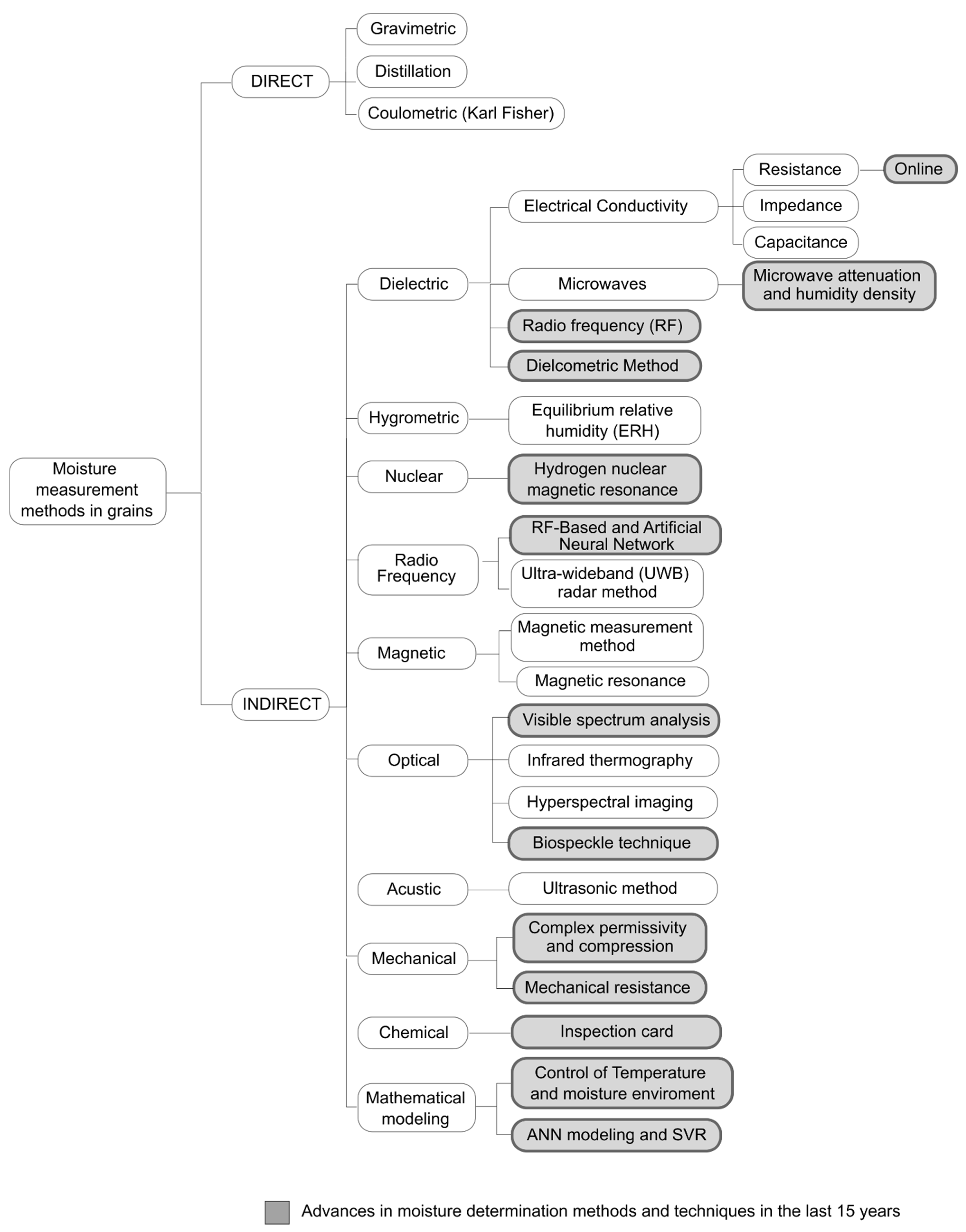



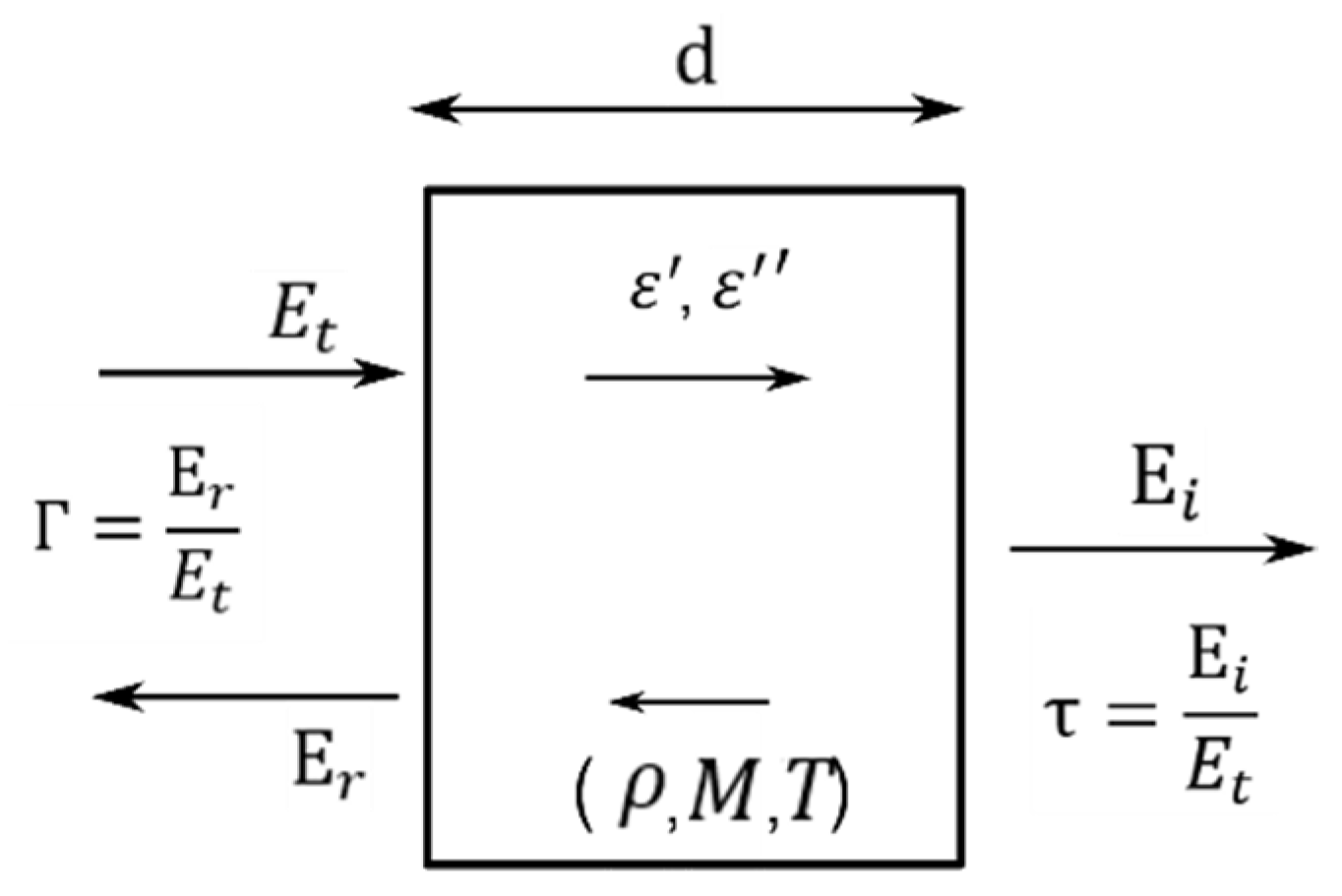
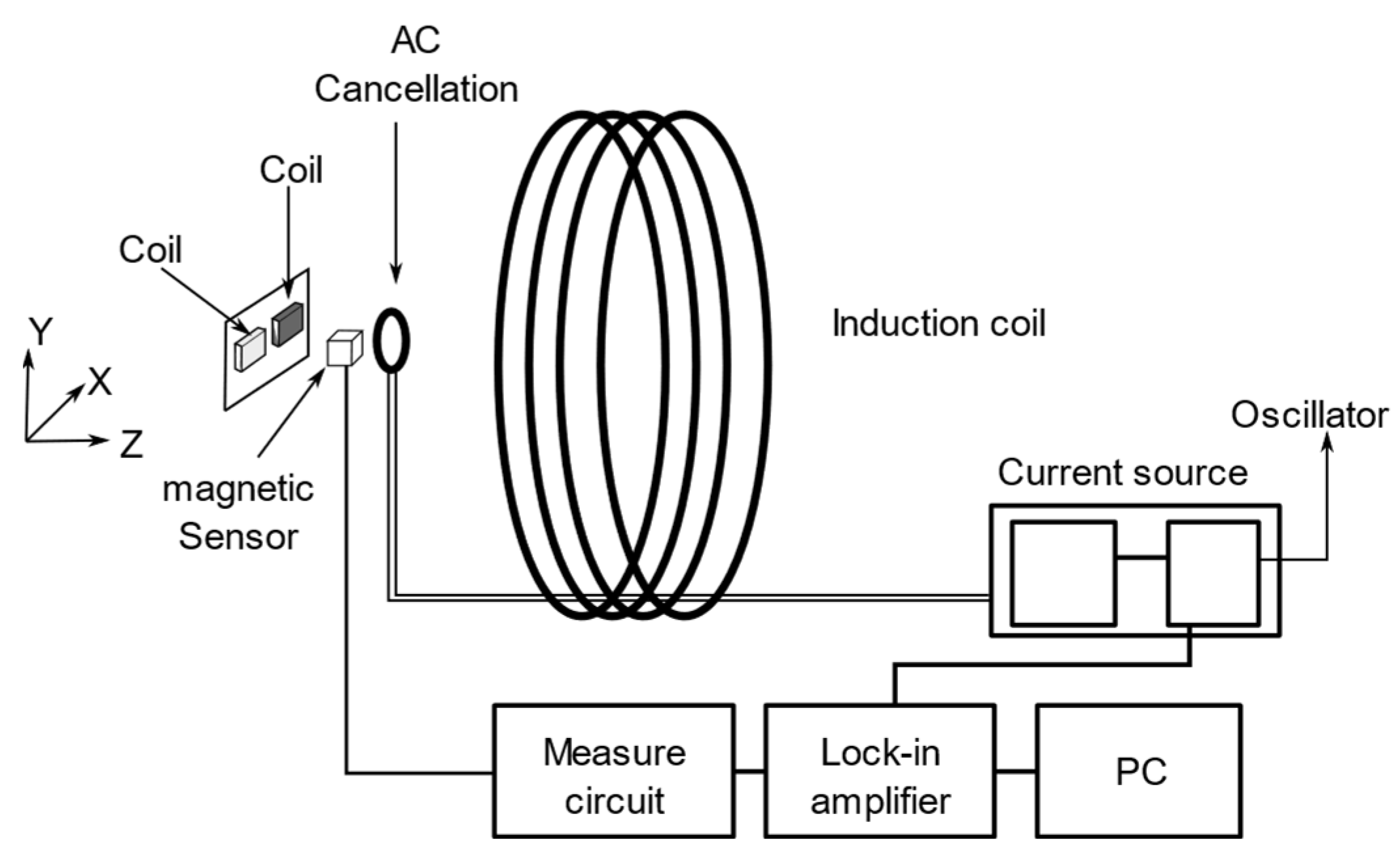
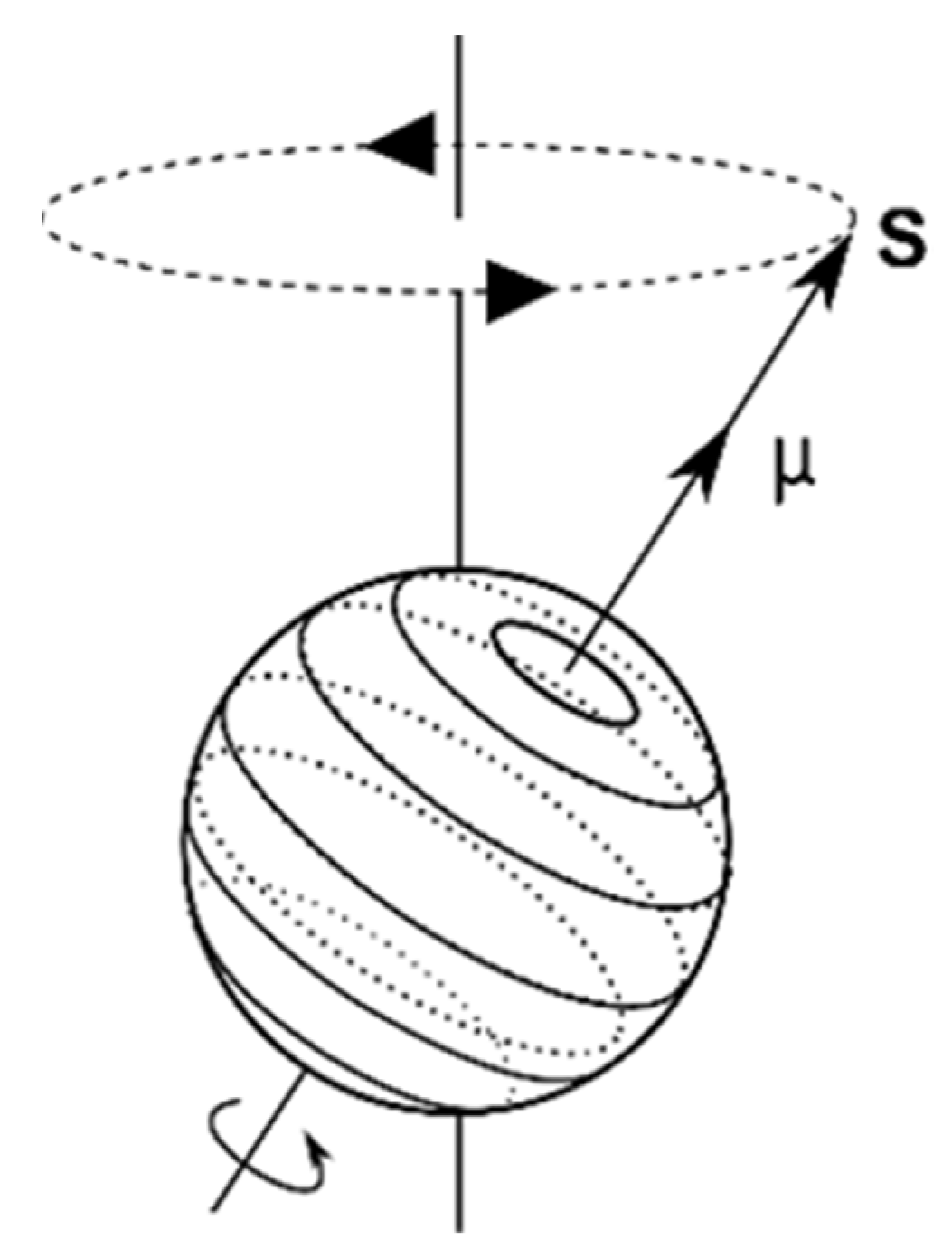
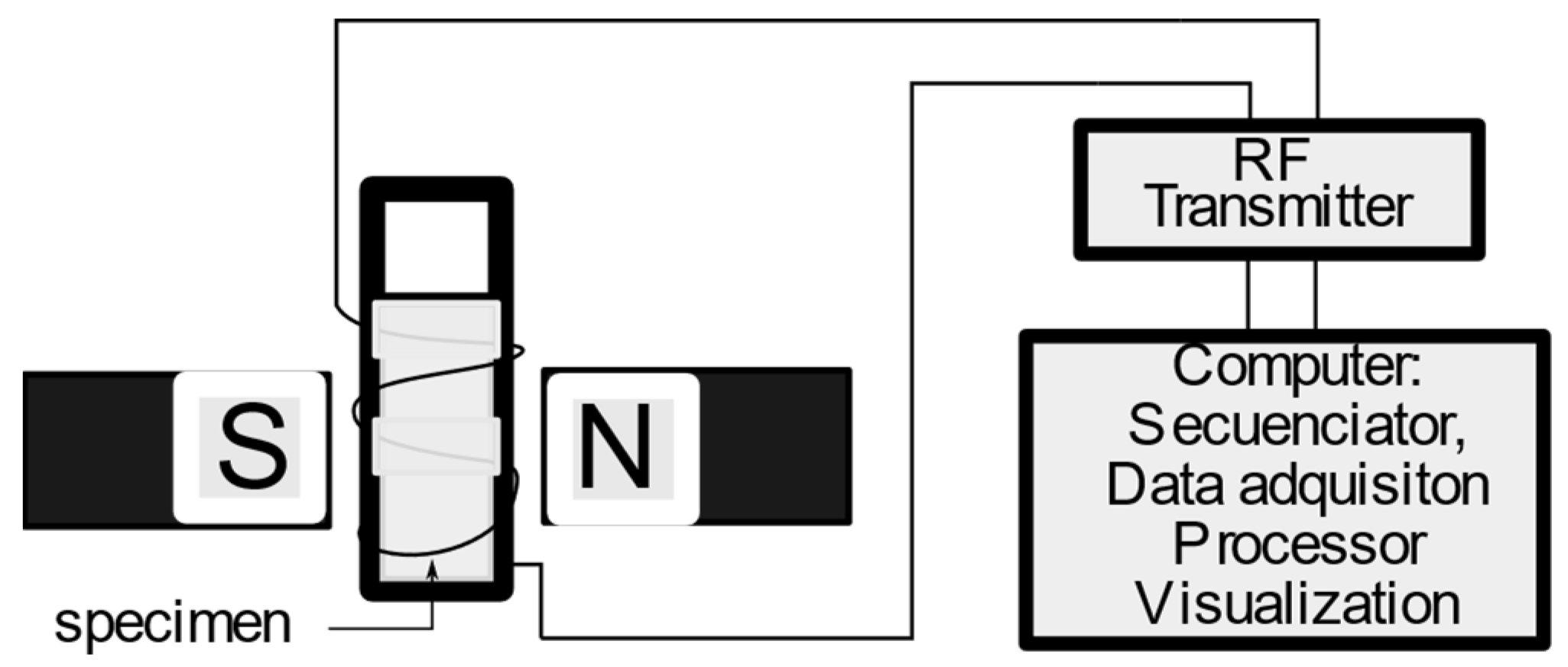
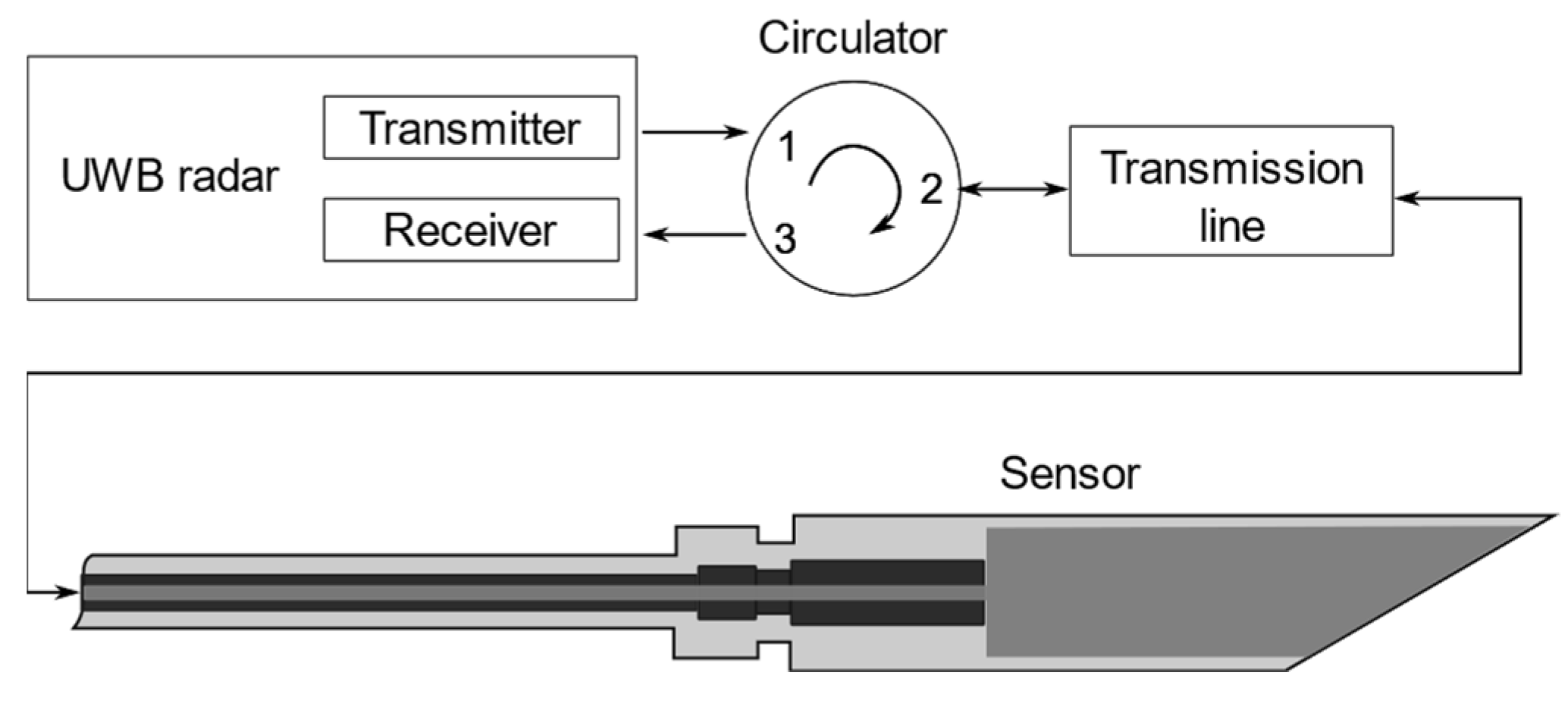
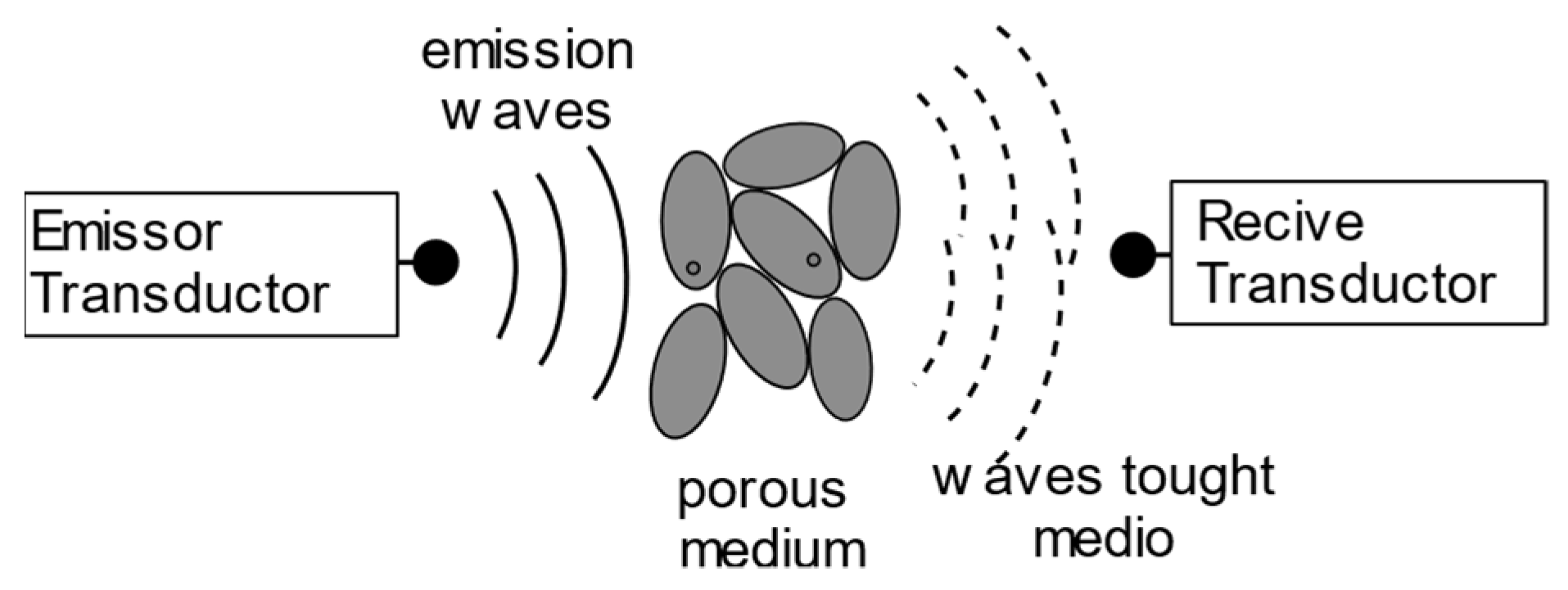




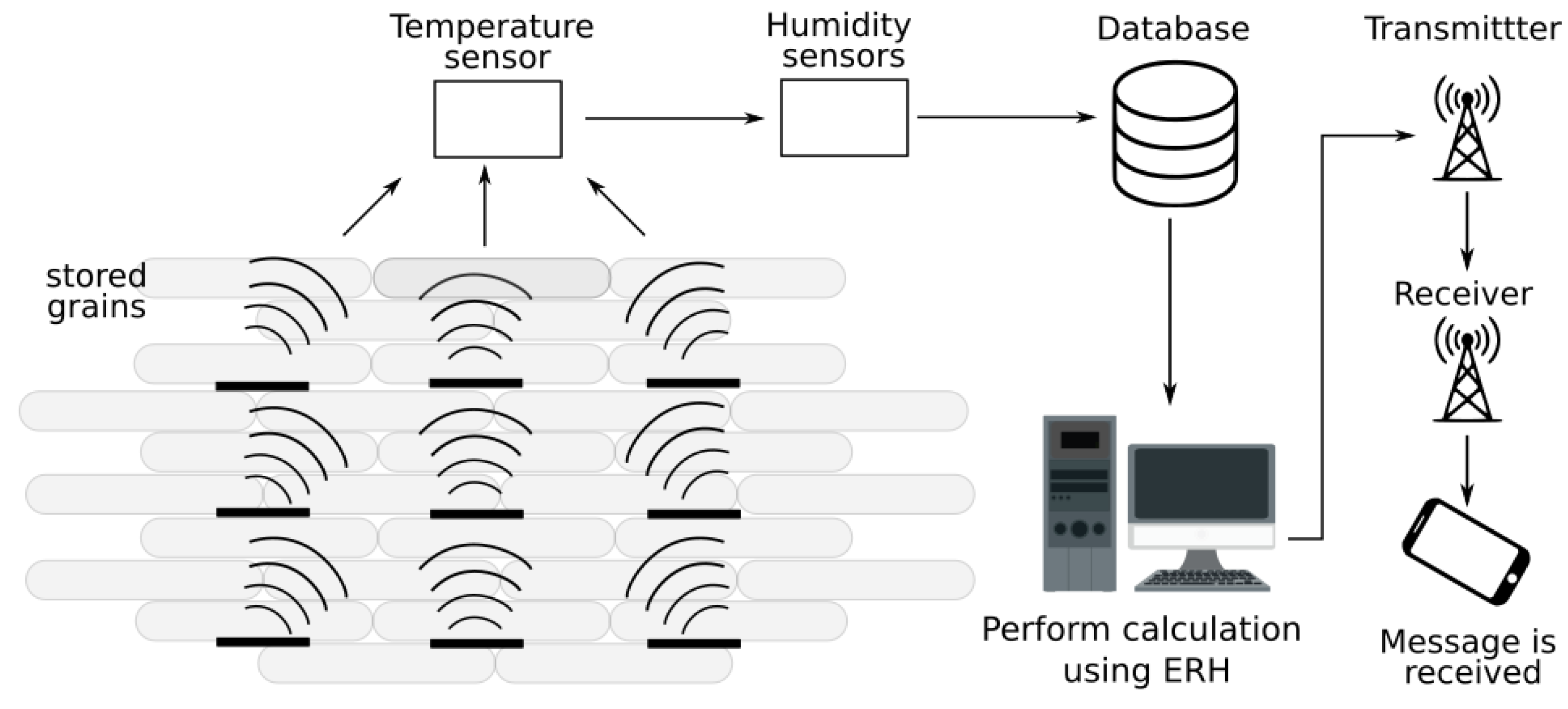

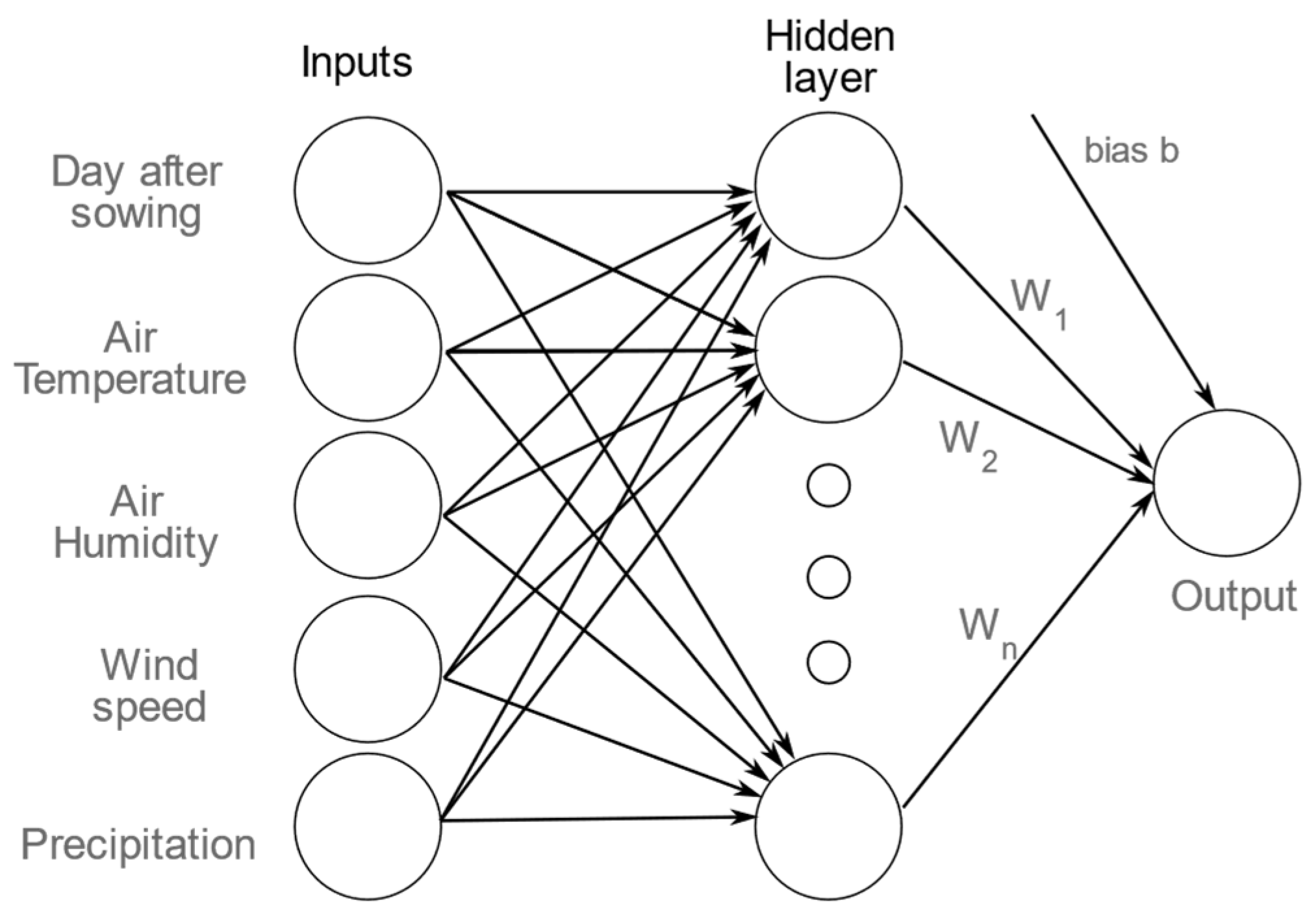
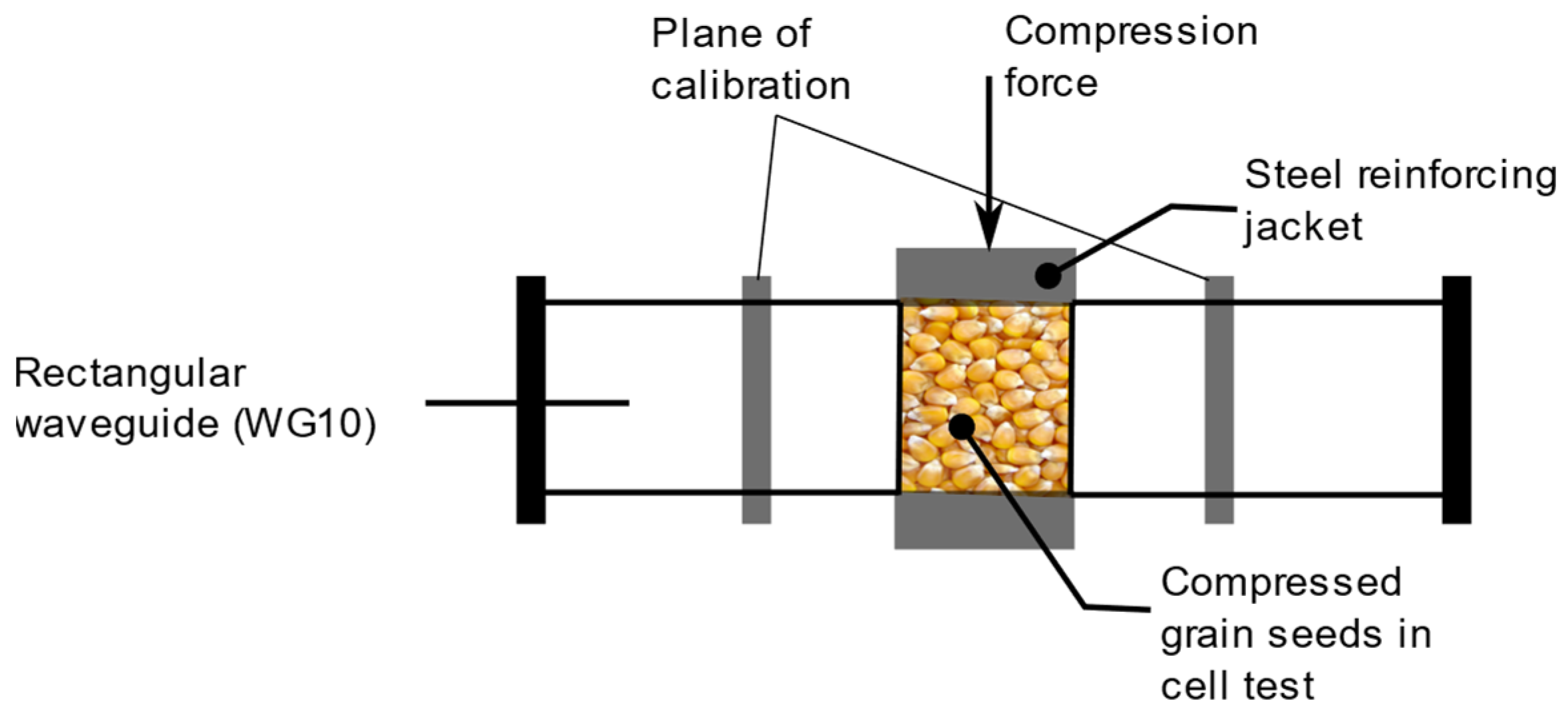
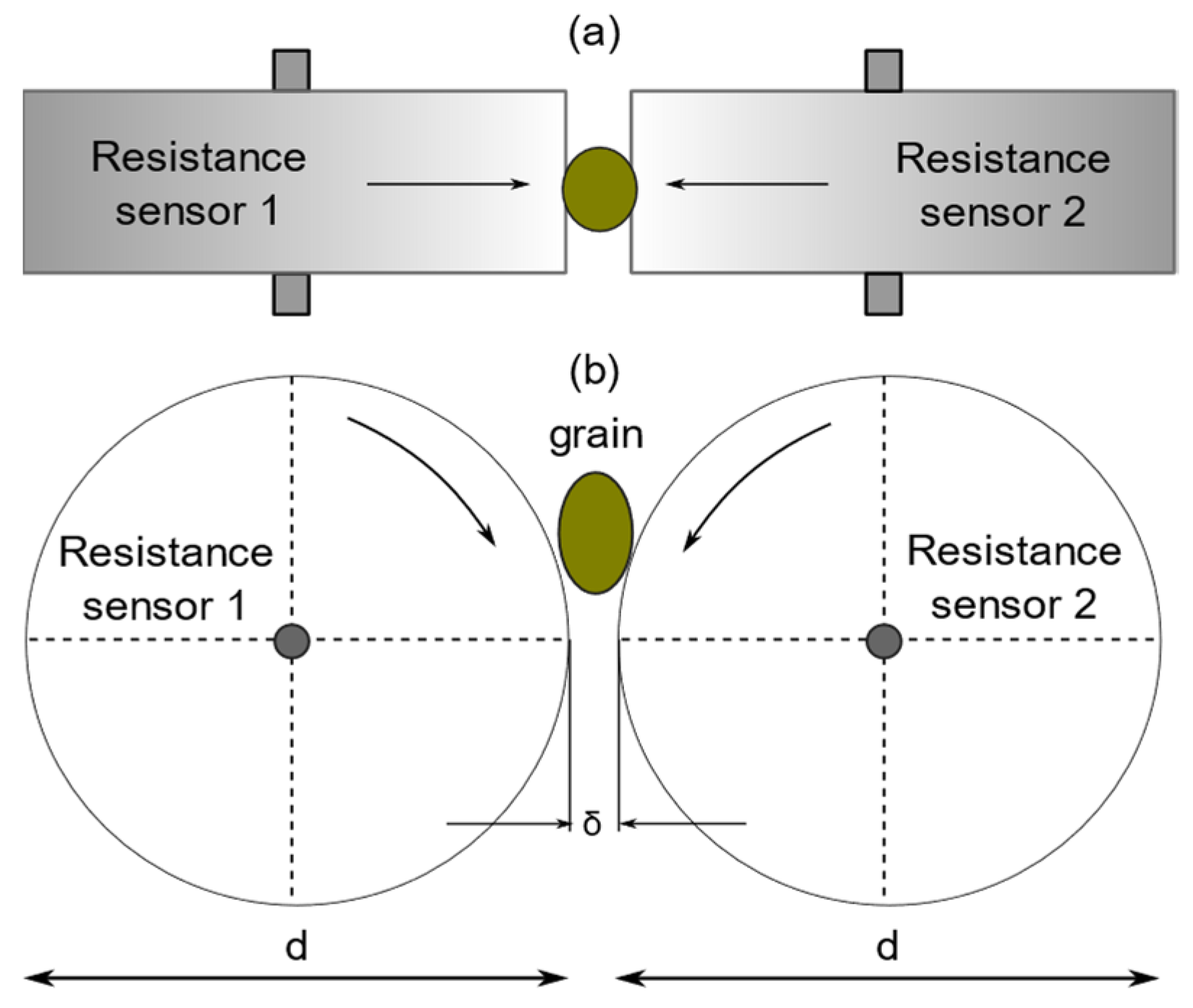
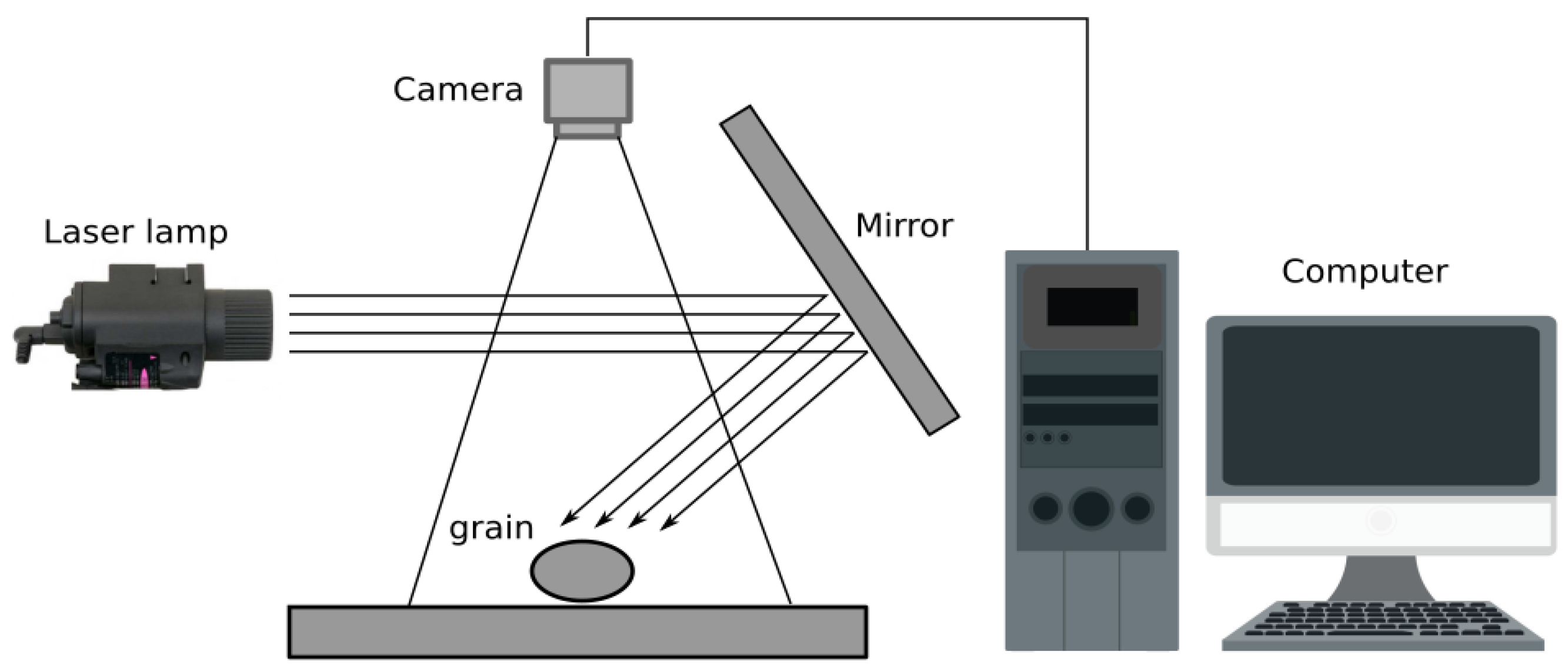

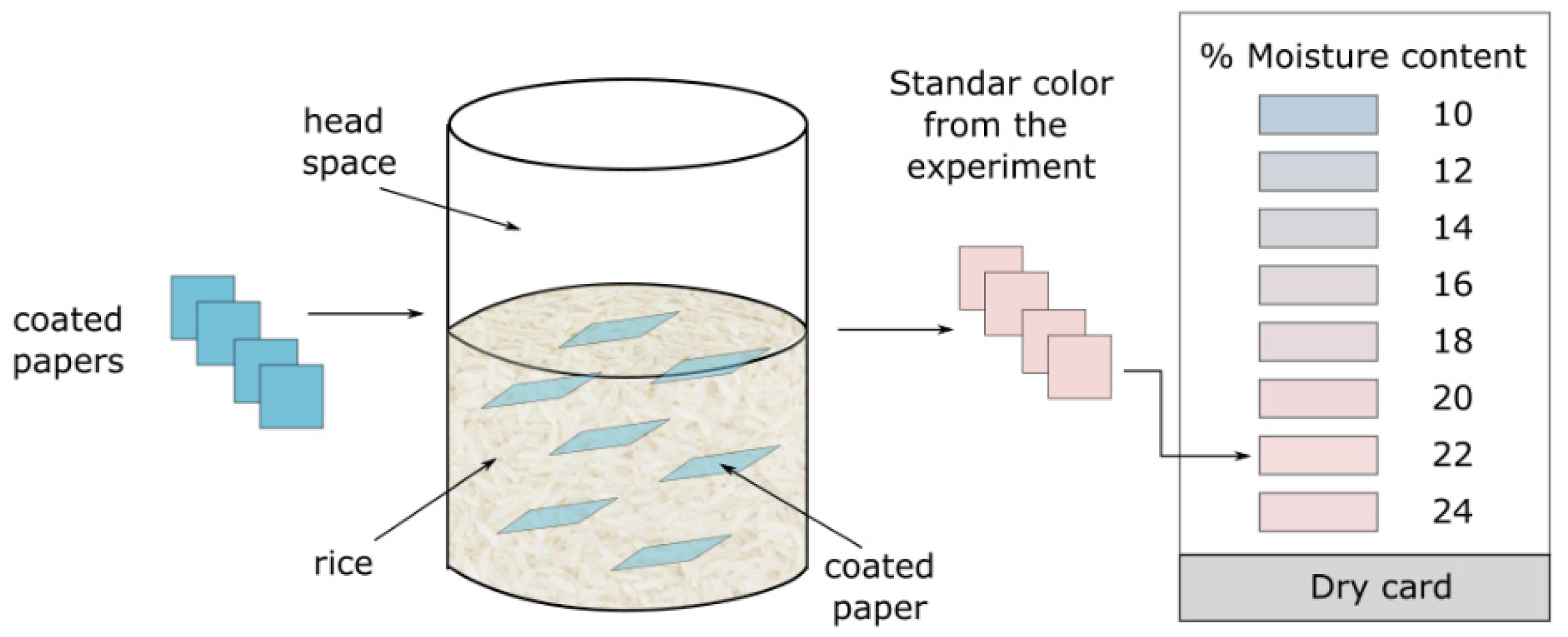

| Method | Operating Principle |
|---|---|
| Gravimetry/Oven [12,13] | Loss in mass by drying |
| Distillation [14,15] | At boiling temperature higher than water |
| Coulometry Method (Karl Fischer) [16,17] | Selective chemical reaction with water |
| Methods | Operating Principle |
|---|---|
| Electrical resistance/impedance [21,22] | Change in electrical resistance/impedance |
| Dielectric constant change [23,24] | Dielectric behavior of a grain sample in a capacitor |
| Microwave [25,26] | Measurement of microwave free space, its attenuation and phase determination |
| Magnetic measurement method [27,28] | Is based on the orbital motion of the electrons due to the presence of an applied external magnetic field |
| Magnetic resonance [29,30,31] | Analysis of free-induction decay (FID) and, in some cases, spin echo (SE) outputs |
| Ultra-wideband (UWB) radar method [32,33] | Reflection coefficient of the sensor and the complex permittivity of the grain are analyzed |
| Ultrasonic (Acoustic Method) [34] | Analysis and comparison of the incident sound wave in grains at frequencies from 5 to 50 kHz |
| Infrared thermography (IR) [35] | Detect difference in IR emitted by a dry sample and a wet sample |
| Infrared spectroscopy [32,36,37] | Analysis of radiation absorption in the infrared spectrum |
| Hyperspectral imaging (HSI) [38,39] | Evaluates drying kinetics of the drying method |
| Equilibrium relative humidity (ERH) [40,41,42] | Determines the humidity as a function of the ratio between the EMC and ERH value at fixed temperature |
| Method | Operating Principle |
|---|---|
| Visible spectrum analysis [58] | Image analysis of the statistics of intensity distribution in images compared with established humidity patterns |
| RF-based moisture content and Artificial Neural Network [60,61] | RF signal strength analysis and use of Random Forest method with one input feature (RSSI/WSN) |
| Prediction using ANN and SVR modeling techniques [57,62] | Estimation by neural network training with inputs: number of days after sowing, air temperature, relative air humidity, hourly wind speed and 6 h precipitation |
| Grain moisture determination by complex permittivity and compression [63] | Electrical analysis of complex permittivity in compressed grain sample |
| Microwave attenuation at 10.5 GHz and humidity density [64] | Uses microwave attenuation at 10.5 GHz and humidity density |
| Temperature and humidity control [65] | The WU equation is used to relate grain moisture to relative humidity and temperature |
| Online measurement by resistance sensor [66,67] | Single-grain analysis with reliable and accurate measurements from an adaptation of resistance method, suitable for measuring on production lines |
| Indirect determination of moisture using the biospeckle technique [68] | Use of laser light, image analysis and moisture value expressed as modified correlated matrix and Moment of Inertia (MOI) |
| Moisture content in the mechanical properties of grains [69,70,71] | Determination of moisture in grains as a function of the variation of mechanical properties in compression |
| Moisture content measurement with inspection card [72] | Indicator cards are used, which discolor on contact with the moisture in the grains, the colour is compared and a moisture reference is obtained |
| Evaluation of grain moisture content by the dielcometric method [73,74] | Use of mathematical modeling and graphical representation of electrophysical processes under the effect of an electric field |
| Method | Accuracy | Operating Range % | Response Time (Minutes) |
|---|---|---|---|
| Gravimetry/Oven | 0.09 ± 0.16 | 10–40 | 2280 |
| Distillation | 0.28 ± 0.42 | 10–35 | 60 |
| Coulometry Method (Karl Fischer) | 0.08 ± 0.13 | 10–35 | 45 |
| Methods | Accuracy | Operating Range % | Response Time (minutes) |
|---|---|---|---|
| Electrical resistance/Impedance | ±0.3 | 1–44 | 0.166 |
| Capacitance | ±0.5 | 1–40 | 0.016 |
| Dielectric constant change | |||
| Microwave | ±0.5 | 0–70 | 0.016 |
| Magnetic measurement method | |||
| Magnetic resonance | 0.01 | 15–30 | 2 |
| Ultra-wideband (UWB) radar method | 1.0–1.4 | 1–26 | 8.3333 × 10−10 |
| Ultrasonic (Acoustic Method) | ±0.5 | 10–60 | - |
| Infrared thermography (IR) | ±0.2 | 20–70 | 0.066 |
| Infrared spectroscopy | 0.09 ± 0.30 | 10–25 | 20 |
| Hyperspectral imaging (HSI) | 0.8 | -- | 15 |
| Equilibrium relative humidity (ERH) | 3.15–3.59 | 1–30 | 20 |
| Method | Accuracy | Operating Range % | Approximate Response Time (minutes) |
|---|---|---|---|
| RF-based moisture content and Artificial Neural Network | 98% | 0–30 | 1–2 |
| Prediction using ANN and SVR modeling techniques | +0.92–2.09 | 0.40 | 5–10 |
| Grain moisture determination by complex permittivity and compression | -- | -- | -- |
| Microwave attenuation at 10.5 GHz and humidity density | ±0.07–0.52 | 12–26 | 1–2 |
| Temperature and humidity control | ±2.67–3.35 | 10–35 | 1–2 |
| Online measurement by resistance sensor | ±0.5 | 10–35 | 5–10 |
| Indirect determination of moisture using biospeckle technique | -- | -- | 0.166 |
| Moisture content in the mechanical properties of grains | ±0.0482–0.1547 | 0–14 | - |
| Moisture content measurement with inspection card | ±1.00 | 10–24 | 30–45 |
| Evaluation of grain moisture content by dielcometric method | 0.1 | 10–50 | 0–1 |
Publisher’s Note: MDPI stays neutral with regard to jurisdictional claims in published maps and institutional affiliations. |
© 2022 by the authors. Licensee MDPI, Basel, Switzerland. This article is an open access article distributed under the terms and conditions of the Creative Commons Attribution (CC BY) license (https://creativecommons.org/licenses/by/4.0/).
Share and Cite
Flor, O.; Palacios, H.; Suárez, F.; Salazar, K.; Reyes, L.; González, M.; Jiménez, K. New Sensing Technologies for Grain Moisture. Agriculture 2022, 12, 386. https://doi.org/10.3390/agriculture12030386
Flor O, Palacios H, Suárez F, Salazar K, Reyes L, González M, Jiménez K. New Sensing Technologies for Grain Moisture. Agriculture. 2022; 12(3):386. https://doi.org/10.3390/agriculture12030386
Chicago/Turabian StyleFlor, Omar, Héctor Palacios, Franyelit Suárez, Katherine Salazar, Luis Reyes, Mario González, and Karina Jiménez. 2022. "New Sensing Technologies for Grain Moisture" Agriculture 12, no. 3: 386. https://doi.org/10.3390/agriculture12030386
APA StyleFlor, O., Palacios, H., Suárez, F., Salazar, K., Reyes, L., González, M., & Jiménez, K. (2022). New Sensing Technologies for Grain Moisture. Agriculture, 12(3), 386. https://doi.org/10.3390/agriculture12030386







